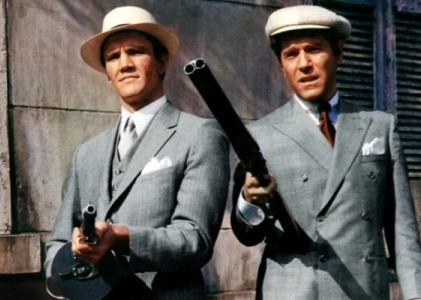If Looks Could Kill
This year's Fashion in Film Festival at the Museum of the Moving Image explores the links between cinema, television, fashion, crime, and violence. A panel discussion on costume design and styling for crime television will take place at 5 p.m. on Saturday, May 12. This essay originally appeared in the 2008 Fashion in Film catalogue.
***
This article is written as a sequel (in two parts). The first part focuses on the modern gangster silhouette and offers reflections on the meaning of the narcissistic aspect of menacing men and their suits. The second part looks at the HBO TV series The Sopranos (1999-2007), and asks why it features so many representations of fat Mafia men who don't always look their best, even when fully tailored. It also examines the postmodern and melancholic implication of The Sopranos' crime, and consumer as well as clothing narratives.
Part 1: The gangster silhouette and mainstream movies
Gangster films are about looks—they are about making the spectator desire what the gangster possesses.
Stella Bruzzi1
James Cagney, Edward G. Robinson and Humphrey Bogart are movie stars who clearly knew how to wear a suit. In Saturday afternoon repeats of films like Little Caesar (Mervyn Le Roy, 1931), "G" Men (William Keighly, 1935), The Amazing Dr. Clitterhouse (Anatole Litvak, 1938), or Rod Steiger in Al Capone (Richard Wilson, 1959) and Ray Danton in The Rise and Fall of Legs Diamond (Budd Boetticher, 1960), movie gangsters reveal a narcissistic preoccupation with clothing, and in the way they link violence and vanity, they often operate to glamorize menace. The suits in gangster movies also help the actors cast a spell over the audience.2 Many of these films provide accounts of American back-street kids who made it to the top of the underworld only to be transformed into suit-wearing "Spivs" who receive their just deserts in the end. All the American actors who have played Al Capone, notably Jason Robards in The St Valentine's Day Massacre (Roger Corman, 1967), share this quality, as do British 1960s fictional villains such as Michael Caine in Get Carter (Mike Hodges, 1971) or Richard Burton as Vic Dakin in Villain (Michael Tuchner, 1971). So why has the suit, "the whole range of tailored jackets, trousers, waistcoats, overcoats, shirt and neck-ties that make up the standard masculine civil costume all over the world,"3 lasted as a clothing style for such a long time? And why is the modern suit—often irritatingly "perfect" in its presentation—adopted by gangster movie icons?
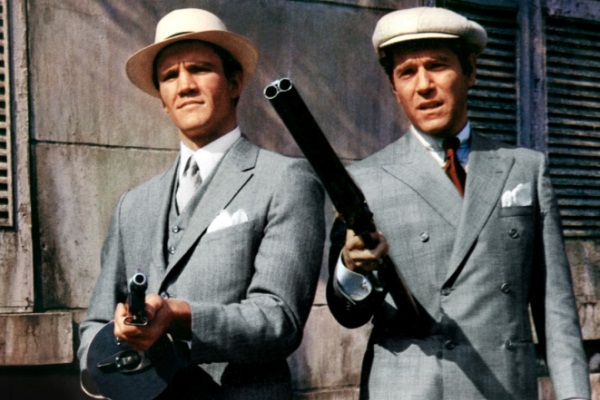
George Segal (right) in The St Valentine's Day Massacre
All the classic gangster films feature forceful masculine figures: lean and mean in tight-fitting tailoring (two-tone or occasionally Savile Row suits). They entertain us by violating the law (and/or prevailing social morality) whilst remaining good-looking and sartorially special, if not always good-hearted. Stella Bruzzi's useful analysis reviews the different ways in which European and American gangster films engage with masculine archetypes and male narcissism. She argues that "vanity in a man came to signify evil and degeneracy (the most obsessively narcissistic gangster is often the most violent)."4 On the subject of their suits, from Cagney's double breasted look to Caine's single-buttoned, high-lapelled 1960s look, they operate to repress almost everything of the man, back behind the defensible lines of the image and also of the tailoring. Even in the more obviously dated Al Capone hats, spats and double-breasted jackets, featured in the TV series The Untouchables (1959-63), where the Spivs are hounded by the svelte waistcoated Eliot Ness, gangster movies seem to use the suit as a boundary that marks the "defensible space" of the body in the way that Oscar Newman used the term to describe both real and symbolic boundaries of architecture.5 Melodramatic alpha-male anti-heroes—and the violent ones too—are clearly transformed when the tailoring works. Even gangster movies that end with moral tales against lives of crime often cannot get the message across, because plot lines do not contain or override the powerful symbolic meanings of the glamorous suits onscreen that the guys lived for—and often died in. As Robert Elms has pointed out, "preposterously expensive tailor-made suits appear to have some sort of alchemical ability."6 The reason so many gangsters wear them in the movies may also be aimed at using the magic of tailoring to block the penetration of the onscreen hostile gaze—a point I shall return to.
The Godfather Parts I-III (Francis Ford Coppola, 1972; 1974; 1990), Once Upon a Time in America (Sergio Leone, 1984), and crime films like Goodfellas (Martin Scorsese, 1990), Reservoir Dogs and Pulp Fiction (Quentin Tarantino, 1992; 1994) all feature action-packed spectacles of hard men wearing sharp, often bespoke business suits. Gangsters as "sexy beasts" appear in full filmic profile, conservatively dressed in designs that fashion historians argue have "stayed virtually the same for 200 years."7
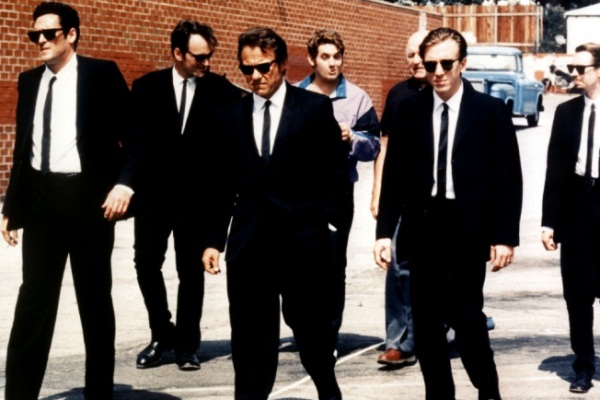
Reservoir Dogs
The Gangster is a "dandy" par excellence, like the 19th-century Dandy who dressed as if going to a funeral and, according to Harvey, made "simple and dark and especially black clothes fashionable."8 Today's movie gangsters exhibit similar taste. Onscreen they are protagonists who carry the action forward, but are also dressed to kill; glamorous figures, in the original definition of the word. These images also offer what Laura Mulvey has described as "to-be-looked-at-ness"9 perhaps because the Gangster, to paraphrase Harvey's account of the Dandy, "renounces plumage, but his image [on the screen] offers a form of masculine display."10
Tarantino, with his lead characters in Reservoir Dogs and Pulp Fiction dressed in black ties and Agnès B suits, uses such styling almost as "genre reinforcement." In fact, Tarantino has argued that suits give gangsters a uniform, one that aids their anonymity: "when the cops come back later and ask, ‘What did they look like?' [you'd say] ‘I don't know—they look like a bunch of black suits.'"
Gangsters are definitely dandyish, but their suits often operate to contain the gangster's inevitable fragmented identity, that may eventually spill over onto the screen (Tarantino's forte) as the crime action accelerates. Gangster suits also fetishize the male body. They offer the spectator a view of what Rebecca Arnold has called "fashion noir,"11 but also a constrained form of male display. Their presence may, to some extent, argue against the case made by J.C. Flügel in his The Psychology of Clothes (1930) about the "great masculine renunciation" of fashion in the 19th century.12 Gangster suits may be contained and sombre, but they nevertheless turn the male silhouette into a lean, mean and sexy fighting machine, accessorized with big guns and black shades, creating an image "to be looked at." Just think about the violent eroticisation of John Travolta and Samuel L. Jackson in Pulp Fiction, with blood and splatter on their suits—their image offers perverse fetishization of menace as sexual spectacle. The suits holds the body like a fetish container that cannot be penetrated by a hostile gaze, and so the red blood (not theirs of course) on the front of the suit becomes symbolic of real guts hanging out, and another form of visual styling that contains the gangster's interiority.
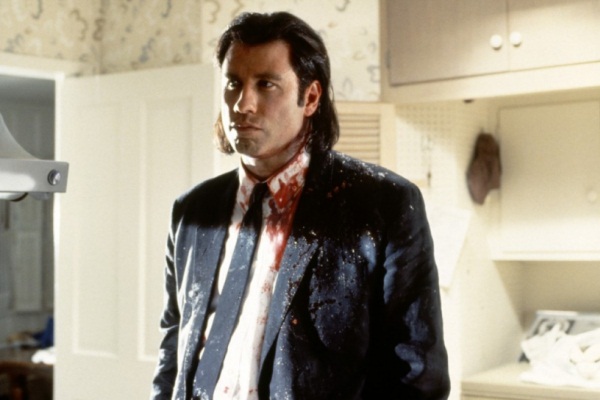
John Travolta in Pulp Fiction
Gangsters on film are mostly all image, all "outside." Dick Hebdige, writing about the Krays in David Bailey's "Box of Pinups," an amazing photographic image of identical twin gangsters, in identical suits, exhibiting identical menace, goes on to offer an ethnographic account of how these men lived within a subcultural "system of closure," and how their image, and their use of the media, was important to their success.13 Hebdige's phrase "system of closure" for me also sums up what a well-tailored gangster suit can do and "contain." We may be bedazzled by the details of pockets, vents, buttons and cuffs that give swagger and charisma to the gangster persona (all fastened, often, with just one button) but actually, the gangster's suit operates to "close" off the inner man who rarely speaks his feelings. Gangsters therefore offer iconic images and even at moments of tense emotional drama are always mysterious, given that so little emotional dialogue is forthcoming. Enigmatic understanding via Godfather-style one-liners is usually the common form of speech; "Michael, I never wanted this for you ..." Don Vito Corleone needs only one line to convey his emotion about the corruption of his hope for his youngest son, who will eventually avenge his father's death.
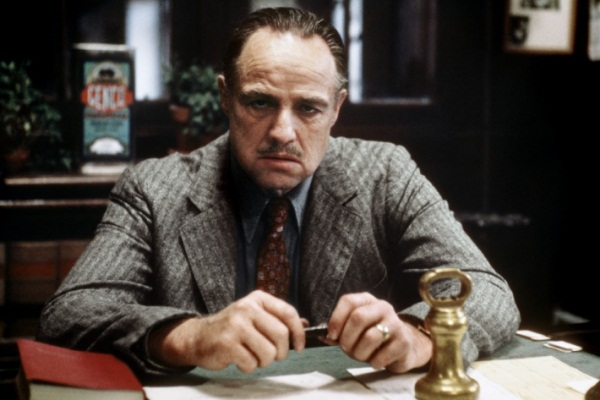
Marlon Brando in The Godfather
This sort of emotional repression, alongside the semiotic effect of a tailored suit onscreen, delivers many different connotations to different viewers. Some knowing viewers are more focused on the clothing than the rest of us and can recognize whether the seams are sewn by Bethnal Green, Italian (Soho) or Savile Row tailors. The gangster "Spiv," who is groomed to excess and holds the scrutiny of the erotic cinematic gaze (for both men and women), is rarely dressed in Savile Row; Italian suits are more popular with these characters—the Establishment and James Bond wear Savile Row. Additional, excessive focus on male grooming and presentation, as delivered by the "Spiv"—as Chris Breward has argued in his book Fashioning London14—serves to emphasize, often by a subtle fashionable touch to the tailoring of an otherwise immaculate suit, the lack of social status of the men in question. I would argue that the Spiv factor, articulated through specific types of suits and excess, is often a way for middle class filmmakers to covertly show the audiences that some tailored characters do not pass as gentlemen or high class (and so end up looking like pimps). In Get Carter when Michael Caine is on the train, dressed immaculately, dining in a first-class carriage and looking fantastically classy in a suit, we can observe that he is out of place—not by his excessive tailoring (delivered by the costume designer Evangeline Harrison) but by the way he wipes the silver cutlery with a napkin and allows one loose hair to fall over his face to show us that underneath, he is not really what he may seem.
Celluloid gangsters, manicured and coiffed to perfection, use fear as a form of glamour that even the fictional characters in the movies want to emulate: "I've always wanted to be a gangster," says Ray Liotta as Henry Hill in Goodfellas (Martin Scorsese, 1990). Liotta goes on to explain why gangster cars, clothes and violent lifestyle inspired his imagination, and why he felt that it offered a better job opportunity than being "the president."
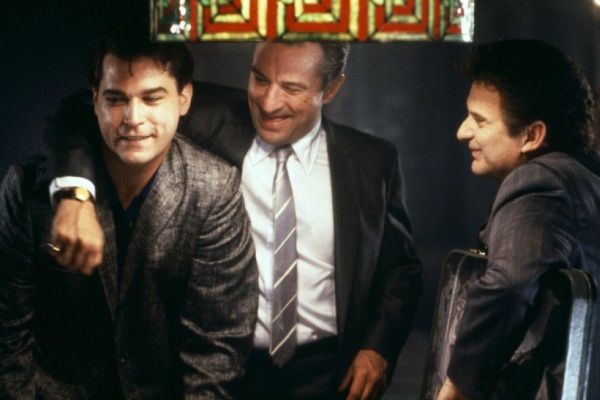
Ray Liotta, Robert De Niro and Joe Pesci in Goodfellas
Yet the suits that gangsters wear, as I have argued earlier, offer an account of masculinity that originated in the 19th century and have come to inform modern definitions of what it means to be a real "man" who leaves it to the girls to offer "display," while he "works." Yet the "work" the filmic gangsters deliver is hardly comparable with the traditional accounts of manual work, or newer accounts of "office" work, and so the suits in gangster movies are excessive even when sober in colour and tailored with restraint. Here, "excess" produces the male suited masquerade15 as response to "lack" (of "use value" connected to the work gangsters actually do). I am arguing, then, that representation of the gangster in terms of style perhaps dates back to the time when men gave up gaudy clothing and decided to be somber, "useful" rather than "beautiful," and because there is a contradiction in terms of the "use" value of the work gangsters actually deliver, the gangster's groomed image is over-determined. This is a surprise, because by the late 19th century, "beauty" as a trope was left to the female species, whose soft feminine clothing contrasts vastly with those in the masculine "work" sphere; in gangster movies it means that feminine women's clothing contrasts vastly with those tight-fitting suits worn on the hard bodies of the male leads. A modernist form, then, gangster suits in the movies are nevertheless contradictory because on the one hand the suit contains feelings and reinforces masculinity as a hard exterior image that constrains some aspects of display. On the other hand, the suit helps to turn the male form into a performative spectacle and holds the gaze, providing narcissistic and voyeuristic identificatory opportunities for men and women, as well as strong homo-erotic overtones connected with the over-emphasis on appearance.
Film directors have kept such gangster movies edgy, however, by ensuring that these male narcissistic fantasies articulated by excessive grooming are tempered by (a) the central character's gradual self realisation (or disintegration) amidst existential dilemmas and moments often articulated in terms of clothing presentation; (b) wry and often humorous reflection linked to incidents where the gangster's behaviour is either outrageous, subversive or linked to life-or-death issues. No wonder gangsters wear suits that are reminiscent of funeral-wear.
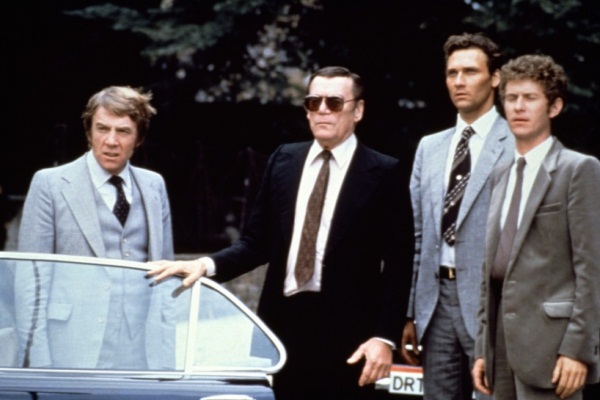
The Long Good Friday
The wry looks and black humour of such life and death moments, or gangster wit, offer alongside the clothing narratives the most pleasurable moments of gangster movies (Scorsese's films do it best). Obviously, gangster movies differ widely and contain too many diverse themes to summarize here, and did change very much in the post-war consumer years when fashion influenced the gangster genre and introduced consumer desire as part of the motivation of the business of crime. In addition to films already mentioned, The Long Good Friday (John Mackenzie, 1980) started to break new ground with the emergence of more reflection and the fading of the narcissistic focus. Low budget British gangster movies such as Face (1997) and Sexy Beast (Jonathan Glazer, 2000) continue this reflective focus and contain many narrative elements that disrupt the narcissistic display and violence associated with the genre, introducing more melancholic moments or "gallows" humour. In part 2 of this sequel, I suggest that Freud's account of "melancholia" and "endless mourning"16 (as well as his account of narcissisms) may be useful to understanding the clothing style and humour, as well as the shifts and motifs in The Sopranos TV series that subvert many of the established codes and conventions of the gangster movie genre.
Part 2: suits and The Sopranos
Lately I get the feeling I came at the end ... the best is over ...
Tony Soprano
The Sopranos can be best described as a long-running mafia TV soap opera. Based on mafia books such as Wiseguy,17 the Sopranos are gangsters with family and weight problems that have filled many prime-time viewing hours of the early 21st century and received much critical acclaim. After 86 episodes, multi-authored scripts and imaginative sets, music, clothes and soundtracks (and countless gangster-style murders), many have found the series and the actors in it utterly compelling. The editor of the New Yorker, faced with the news that The Sopranos would finally end in June 2007, went as far as to pronounce it "the richest achievement in the history of television."18 I agree with him. One of its biggest achievements has been to transform the shape of the gangster silhouette from well-clad lean and mean fighting machine into all underbelly. Unlike in gangster movies, there is little erotic objectification or the male body in The Sopranos, or simple accommodation of narcissism. The men in it are rarely handsome in the classical sense and are rarely found dressed to kill in pin-striped business suits; the narratives are also very complex and often feature many unresolved moral dilemmas.
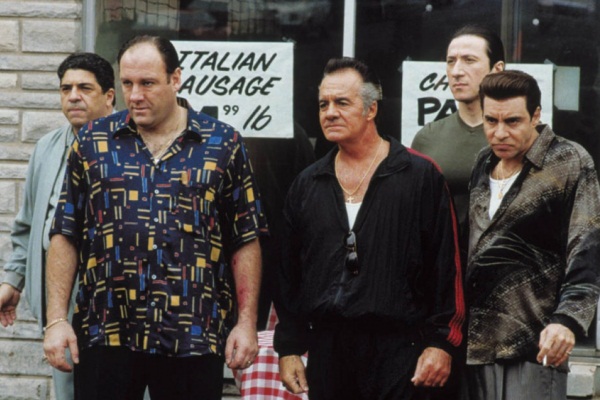
James Gandolfini in the The Sopranos
Unlike the traditional gangster movie that depicts handsome American-Italians—hard men with ticking facial muscles, prancing about with big guns and sharp suits whilst involved in turf wars, The Sopranos "guys" from the outset appear very different. The drama is centred not so much on image and how they look, but on how they cope.
The Sopranos are not just heavyweight TV gangsters. They are in fact played by overweight white men who, despite their tattoos and the series' trendy theme tune by the British band Alabama 3 ("woke up this morning—got myself a gun"), are almost anti-fashion. They share their bulk and their attitudes towards women with Hip Hop's Gangsta-cool contingent rather than The Godfather's gangsters; in fact, like their counterparts in rap music, they clearly support materialism, sexism, violence, homophobia, drugs and murder. But the main difference is that they often wear bland golfing not bling designer sportswear. This is not an accident. Since the second series, The Sopranos were styled by Julia Polsca who says that Tony's signature look is "loud short-sleeved shirts, many of which come from a company called Burma Biba," adding that she has been "chastised" for showing Tony in shorts "by the owner of a store where I shop for some ‘mob attire.'" Polsca also says that she was told: "A boss would never wear shorts ... it's undignified."19 She defines the look of other significant Soprano characters as: "Pussy—polyester coordinated ‘sets'; Paulie—running suits, often by Alan Stuart; Furio—tight knit shirts; Silvio—loud silk shirts and slacks." Like so many overweight rappers, The Sopranos men offer little erotic or sartorial pleasure to the female viewer, even if there is much emphasis in the series on the fact that they are not too fat to fuck—Bada Bing girls on top, of course.
As a male icon, James Gandolfini as Tony Soprano looks to me a bit like my dad at the same age. Gandolfini simply does not compare with Robert de Niro, Al Pacino, or other gorgeous Hollywood actors who have played Italian gangsters on the big screen. With the exception of Michael Imperioli who played Christopher Moltisanti (the only character in the TV series to wear dark glasses and look good in a suit), The Sopranos shows the contemporary underbelly of America as it really is—overweight and often emotionally overwhelmed. These hard men, such as Vincent Pastore who plays Salvatore "Big Pussy" Bonpensiero, are not as cool as cucumbers but are often deeply agitated. Paulie "Walnuts" Gualtieri, who has wispy uncontrollable hair and anxieties about health and gang status, is typical. The Sopranos is full of men like these, whose lives hover between comic reality and the stuff of nightmares. We know that any exchange we watch could tip without warning from pleasantries and humour to murder (here, there is a debt to films like Goodfellas, as David Chase, the creator of The Sopranos series, has acknowledged).
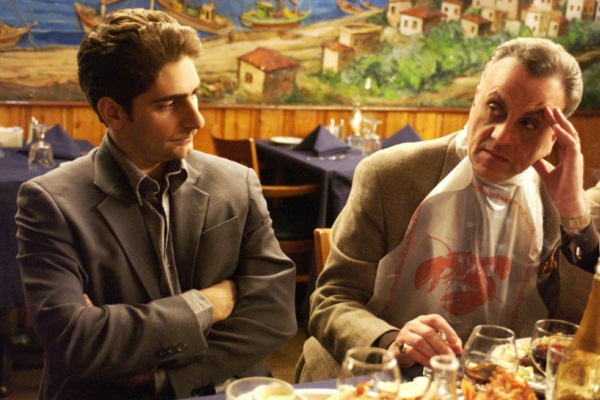
Michael Imperioli in The Sopranos
Tony Soprano is not an old movie style "outsider," casting a sinister shadow over the American family, but its antithesis. He is regularly shown inhabiting a domestic world in casual clothing where his wife Carmela and his children's presence is important, and compares with any regular representation of the American family. Geoffrey O'Brien argues that Tony Soprano is a "domesticated gangster inhabiting a world in which women had equal dramatic weight. It is with his wife, his daughter, his sister, his mother and his analyst that Tony engages in his deepest emotional struggles."20
Tony's main character difference, therefore, is that he is in the middle of a mid-life crisis and develops his inner life onscreen via encounters with women and regular visits to his shrink, where he often sits and looks at his feet (Allen Edmond, evidently, supplies most of Tony's shoes, including his golf shoes). His shrink is Dr Jennifer Melfi (Lorraine Bracco), who wears business suits by Vestimenta and relentlessly strives to make Tony Soprano aware that not all women are there for sexual pleasure, and that life is complicated and dependent on the choices we make. Her independence and different world view is represented by her clothing, which looks more "professional" than that worn by other women in the series, as well as by what she says to him. Outside the therapy room, and outside his domestic life, Tony's erotic but dismissive gaze at women (the lap dancers and strippers in Silvio's nightclub Bada Bing where Tony has his office) is comparable to the way women in Gangsta music videos are portrayed. But in The Sopranos there are no soft lenses on either women's bodies or faces, nor men's: here the camera shows us the full pound of flesh.

Lorraine Bracco in The Sopranos
It's true that some Gangsta Rappers, such as Notorious BIG and Fat Joe, are overweight too: approximately the same size as Tony's colleague "Big Pussy" Bonpensiero (who looks over 20 stone) or Bobby Bacala (played by Steven R. Schirripa who is bulked up for the series). In Series 6, Bacala, sweating after playing baseball, casually tells Tony (who asks what he weighs) that he is "265lbs!" Few women I know find any of the Sopranos men attractive, and some of the depiction of overweight men (Pussy in the gay nightclub) verges on the grotesque as an aesthetic trope. Silvio Dante (played by Steve van Zandt) looks smaller in comparison to other male Sopranos characters, and so his character is made to stand out with his big hair quiff and terrible, brightly coloured Versace ties that he wears to the Bing.
The difference with The Sopranos, compared to most Hollywood gangsters on film, is that TV allows for more character development as the weeks go by, as well as the ability to reference gangster "movies." I have given up counting how many times The Godfather is mentioned, and not just by Christopher who is writing a film script, but by many other The Sopranos characters, including Tony's son A.J. (Anthony Junior, played by Robert Itler), who is shown to measure his life experiences against mafia "fictions," often unable to balance his reality with Hollywood mafia films. Also, Tony Soprano and crew are given the sort of postmodern inner lives and conflicts rarely seen in early gangster films or in gangsta bling MTV music video promotions. In fact, The Sopranos is bursting at the seams with issues bigger than the size of the bum or waistline of the gangster's latest squeeze, or the clothing labels chosen for the actors to wear in the series.
What I love the most about The Sopranos is not just that the men are clearly not perfect movie gangsters, but that there is not one truly fashionable character in any of the 86 episodes: even women like Carmela (acted by Edie Falco) who are seen to care about image and dress for the occasion—a lilac beaded dress from Cache for dinner with Tony, or in mob funeral bling—have no real fashion sense at all and leave the audience wondering. Many of the female characters either wear so-called suburban but frumpy respectability (Carmela in St John knits), or if they are sexy girlfriends like Adriana (played by Drea de Mateo), they dress in lycra running kit, or worse. Adriana is seen playing an American in Rome, for example, in tight fitting zebra animal prints; when nightclubbing, black stretch vinyl or bad taste 80s Escada or Dolce & Gabbana trousers make an appearance. Even at funerals The Sopranos women are dressed to the nines, and exhibit the sort of bad bling taste (too many buckles and motifs on the clothing) expected of the nouveau riche. The taste represents, like the layers of fat on the men, hints at working-class roots. Indeed, this focus on "bad taste" is so successful that Polsca received an Emmy nomination for an episode in which she dressed the actors for a mob funeral.
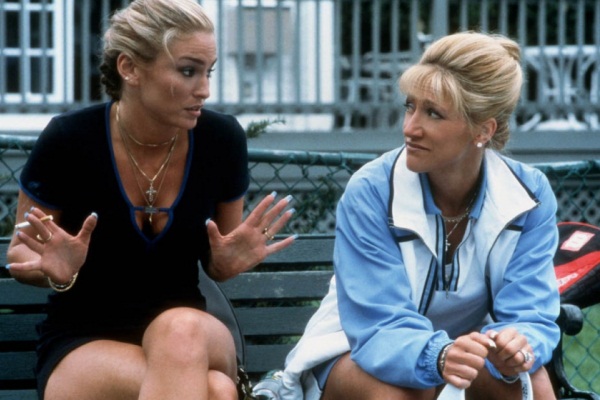
Drea de Matteo and Edie Falco in The Sopranos
Despite the apparent bad taste, Tony and other Soprano characters are compelling onscreen because it is what goes on in their heads, rather than what they look like, that seduces us. Tony Soprano is so stressed with life's problems that we feel sympathy for him. His mother is scripted as a monster, and the black dog of depression follows him everywhere, so we watch him taking Prozac, and getting rightfully "down" when his mum and his Uncle Junior really do conspire to kill him.
Tony's depression is reasonable in the account Freud gives of both normal and pathological melancholia, which Freud says may arise in reaction to the loss of a loved person, or to the loss of some abstraction which has taken the place of one, such as one's country, liberty, or other ideals. It is, however, how Tony deals with the loss of so many boundaries—his straightforward abandoning of so many emotional ties, his self-centered transformation of his losses (particularly of the colleagues he is forced to dispose of) to make sense of it all—that provides the quality that gives The Sopranos more depth than the account of narcissism can deliver. Tammy Clewell sheds further light on this. In her definitive article "Mourning Beyond Melancholia"21 she locates theorists after Freud who have developed the account of melancholia, including the psychoanalyst Julia Kristeva, whom she paraphrases as arguing that:
mourning defines a repudiation of attachments as a condition of normal subjectivity and signification. Conversely, the failure to mourn the mother results in an inadequate integration into society that may lead to clinical depression, a condition Kristeva sees as arising when the subject has "been unable to find a valid compensation for the loss."22
Tony never seems really to get over the process of mourning (even if it appears that he comes to understand the loss of his mother before she actually dies). His lifestyle, which often puts him at risk of being killed, requires him to repress mourning. In fact, death plays such an integral part in his business that he clearly needs to incorporate loss into his daily masquerade23 and to repress his strongest feelings. So despite the wins, and the up moments, there is a sense of "failed" mourning. His mother Lydia is represented as a cynic too, and is heard to say to her grandson in her dying moments, "It's all a big nothing." No wonder Tony is represented as being unable to find valid compensation for his life of crime, and that some fashion images from the series—such as those shown in the Vanity Fair editorial (April 2007)—easily move from grunge to abjection.24 Despite his family, the other women and all the wealth and riches he has access to, what has been lost is Tony's belief that the mafia and the material comforts he derives from the job are really worth it.
At happier moments, all this is well hidden, when Tony engages with his family or hits the town with the boys. In between he talks philosophy with the Canadian geese that pass by his swimming pool, or gets psychological advice from his therapist to cope with random panic attacks caused by his daily life of crime, without really understanding the essence of his dilemma. When the shit really hits the fan, he focuses on what is for dinner, like a proper Italian.
In fact, much of the series is devoted to what I call emotional eating. Tony is often seen near the fridge "at home" in a shapeless white dressing gown or PJs, wolfing down bowls of ice cream and a lot of emotion, all hinted at by the way the camera pans down to scan the rolls of fat covering his stomach. Geoffrey O'Brien suggests that this focus on abject bodies is also evidenced by the fact that a great number of The Sopranos scenes are set in "hospital rooms, retirement homes, and funeral parlours ... showing a beauty pageant of the body in decline ...."25 I would go even further and argue that hospital and other dramas that focus on gore—from CSI to The Sopranos—offer a morbid gaze26 at abjection, which delivers voyeuristic pleasure to viewers.
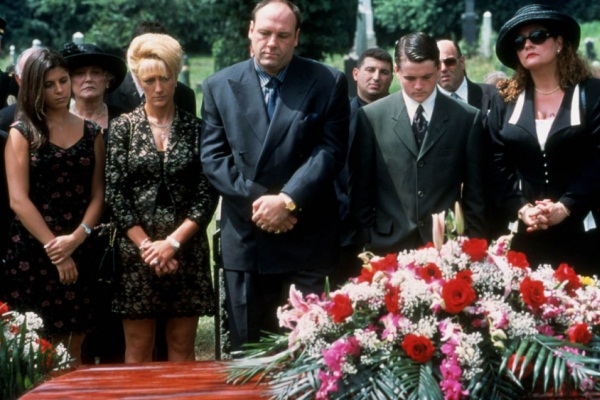
The Sopranos
Tony Soprano does work as an authentic representation of a bona fide mafia boss, precisely because we see him making a living by grabbing the spoils from hi-jacked lorries, skimming construction contracts, running illicit gambling schemes, and committing the violence and murders that are necessary to enforce his business deals. As a consequence of a business and legal threat, he is "forced" to murder his nephew's girlfriend Adriana as well as his best friend Sal, and later his friend and nephew Christopher. Despite this carnage, we remember that he has told his psychiatrist he believes that deep down he is still a "good guy" and "family man." Despite the many murders Tony orders or commits himself, somehow we believe this too, although towards the end of the last series his complicity becomes less easy to forgive, as do some of his awful leisure-wear choices.
Tony Soprano and colleagues save "dressing up" in suits for special occasions—funerals, weddings and mafia business. Even then their overweight frames can rarely display the sartorial elegance expected of anti-heroes in traditional American gangster films. Yet, Tony Soprano occasionally does pull off the look, so much so that he has featured on the front cover of Vanity Fair, in a dark suit and draped byoverover a near-naked Adriana. While it is not true to say that his style does not matter, the fact that he does not look like a stereotypical gangster movie hero doesn't mean he isn't sexy. His lack of model looks and extreme bulk merely help to enhance issues about normality/abnormality that are integral to the attraction of the series.
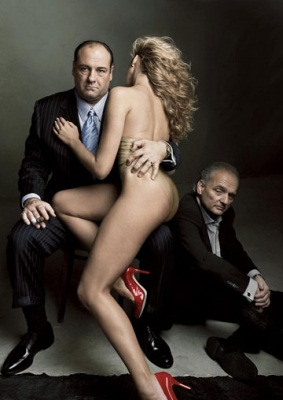
Image for the cover of Vanity Fair magazine
What The Sopranos shares with most of the Hollywood gangster movies is the central concept that gangsters are human beings like the rest of us, with domestic problems and personal issues. They are not simply good or evil. The main difference is in the way this humanity is represented. More than any other mafia fiction, The Sopranos connects crime to everyday consumer culture and consumer desire, and offers a distorted mirror image of the truly warped ways of life we see around us and which we have been slowly conditioned to accept as inevitable. It is within these complex narratives that we see a glimpse of a critique of the American way of life, via the representation of the ordinariness and banality of life in the criminal underworld. Tony tells nosy neighbours that he works in "waste management," and this metaphor says it all about an underlying critical stance of the series. The wasteful and bulk packaging that is typical of consumer goods, as well as the bodies of gangsters in The Sopranos, articulate environmental concerns about Tony Soprano's life of crime and what taking the American dream of "plenty" too far actually leads to, with clever subtlety.
The opening scenes of The Sopranos, grey and iconic, suggest that the action could be in any place, at any time; it is almost "supermodern" in its emptiness.27 The action itself is actually located near The New Jersey Turnpike, where the northern part has few old-fashioned mean streets and instead reveals "nowheresville" at its worst; this backdrop and the clothes influence the feeling of the series. For example, when Robert Loggia as Feech La Manna is released from prison, he continues to wear some of his old clothes (lots of Banlon shirts); yet he still blends the out-of-real-time backdrop well, and fits in with the none too fashion-forward Soprano guys. And it's not just the fashion. Some of the crimes perpetrated seem dated too, about 20 years out of sync.
What is absolutely up to the minute about The Sopranos series, however, is not just this postmodern slippage of time, but the way distinctions between good and bad are not always maintained in black and white, but blur into a grey supermodern landscape; likewise, the clothing often drains from hard black to grey and soft nondescript shades of beige, or washed-out grunge colours.
Gangster films have always been persuasive because they do the opposite—they dress up crime, and offer powerful iconic images. They also often make connections between the way business and crime operate, raising questions about whether or not criminals are so different from the rest of us. The Sopranos does this with less sartorial elegance but perhaps with more wit and brilliance, and tries to answer these questions (or dilemmas?) in a post-industrial global crime context where Russians, Albanians and many other ethnic groups involved in the business of crime in America are shown as marginalized and are perceived to wear different clothing and exhibit different value systems from the established American-Italian mafia "made" men with whom they "cooperate." Almost anything goes: after the Iraq War and scandals like Enron, nothing is surprising and perhaps this acceptance of cynicism is what we should question in terms of what effect The Sopranos has on the world in terms of the meanings in circulation. The Economist suggests that the series "overturns moral certitudes" and observes that "the tensions created by the growing global reach of shows like The Sopranos may prove far more difficult to manage in the long run than the tensions created by the passing neo-conservative moment."28
The Sopranos is not just another form of American colonialism of TV, or fashionable gangster fiction where the actors will be remembered as much for what they wore as for their roles or the violence they delivered. Instead, The Sopranos offers not just a new look at the male silhouette in suit styles and shapes, but also a new and complex look at consumerism and the "American way."
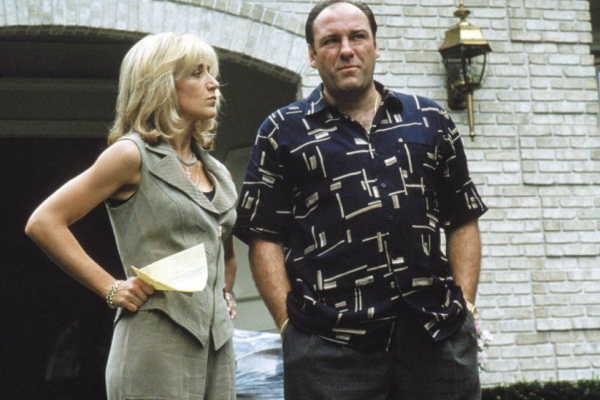
Edie Falco and James Gandolfini in The Sopranos
Aside from its different view of the gangster silhouette, The Sopranos does not do anything radical like challenge gender stereotypes. Crime dramas often seem to try to ignore the influence of the women's movement (unless they make the character exceptional), and The Sopranos presents no female characters at all whose desire, or even fashion sense, can transform their circumstances. Despite the promise of fiery women in the earlier series, few women (those that are not lap-dancers or prostitutes) are seen to make a successful and independent wage from crime in the way true-crime biographies—from Moll Cutpurse to Shirley Pitts—indicate that women have done so.29 Instead, the Sopranos women get to be duped wives and sexualized girlfriends, difficult mothers or dutiful daughters. But the anarchic power of Tony Soprano to live and sort out his life his own way, as well as to offer a humorous and wry reflections on crime and life (which is the biggest pleasure of the series), may not look stylish or beautiful, but it is of course more compelling than middle-class angst or smart-arse attempts by fashionistas to express so-called "superior" taste.30
The moral complexity of The Sopranos is certainly superior to any other gangster movie or series, perhaps because it anticipates an intelligent viewer. The Sopranos shows us that crime might pay, but criminals are rarely happy people who have found themselves, or use money to "better" themselves or even dress well. Consequently, The Sopranos has few radical statements to make, except for its account of the amorality typical of contemporary consumer culture. It features criminals who, just like the law-abiding majority of Americans and the rest of us, often make idiotic consumer or romantic choices. Ultimately, Tony Soprano is sexy because he is attractive and powerful. It is here that the word "glamour" is useful, in the alchemical sense of spell-making, rather than in the sense of wanting to aspire to be just like the icon. Tony Soprano casts a spell because we have watched him for almost eight years inside this never-ending mafia soap opera, and he has reached parts of our hearts and minds that other mafia stories have not reached. We have seen his multiple faces, multiple roles and multiple worlds. The Sopranos as a representation has redefined crime as a way of life as well as the gangster genre. It's not just the historically specific form of the suit as worn by gangsters in the movies—and the gangster silhouette—that has been redefined by The Sopranos, but also the idea of the ordinariness of crime and crime families. We see that the mob, in an era of diminished expectations, are not as unusual or as special as Hollywood once led us to believe, and that there may be no final, transcendent happy ending for them or us.
With thanks to Alistair O'Neill, Caroline Evans, Suzanne Moore and Adam Thorpe for their helpful comments on this article.
1. Stella Bruzzi, Undressing Cinema: Clothing and Identity in the Movies (London: Routledge, 1997), p.87.
2. The original meaning of the word "glamour" was the act of casting a spell over someone, particularly to change how things appeared to him or her. The primary modern meaning of the word relates to fascination, charisma, beauty or sexual attraction.
3. Anne Hollander, Sex and Suits: The Evolution of Modern Dress (New York: Kodansha Globe, 1994), p.3.
4. Bruzzi, supra n.2, p.69.
5. Oscar Newman, Defensible Space (New York: Macmillan, 1972).
6. Robert Elms, The Way We Wore: A Life in Threads (London: Picador, 2005), p.266.
7. Hollander, supra n.4.
8. John Harvey, Men In Black (Chicago: University of Chicago Press, 1996), p.31.
9. Laura Mulvey (ed.), Visual and Other Pleasures (Basingstoke: Macmillan, 1989), p.19. NB, Mulvey referred to female, not male figure as object of the gaze.
10. Harvey, supra n.9.
11. Rebecca Arnold, Fashion, Desire and Anxiety: Image and Morality in the Twentieth Century (New York: IB Tauris, 2001), p.74.
12. J.C. Flugel, The Psychology of Clothes (London: Hogarth Press, 1930).
13. Dick Hebdige, "The Kray Twins—The Study of a System of Closure" (Occasional Paper, Birmingham Centre for Cultural Studies, 1974).
14. Christopher Breward, Fashioning London: Clothing and the Modern Metropolis (Oxford: Berg, 2004).
15. The argument that men as well as women masquerade can be found in Mark Simpson, Male Impersonators: Men Performing Masculinity (New York: Routledge, 1994).
16. Ernst L. Freud (ed.), Letters of Sigmund Freud, Tania Stern and James Stern trans. (New York: Basic Books, 1960); Sigmund Freud, On Narcissism: An Introduction (standard edition 14, 1914), pp.73-102; Sigmund Freud, Thoughts for the Times on War and Death (standard edition 14, 1915), pp.275-300; Sigmund Freud, On Transience (standard edition 14, 1916), pp.305-07; Sigmund Freud, Mourning and Melancholia (standard edition 14, 1917), pp. 243-58; Sigmund Freud, The Ego and the Id (standard edition 19, 1923), pp.1-59.
17. Nicholas Pileggi, Wiseguy: Life in a Mafia Family (New York: Pocket Books, 1987).
18. David Remnick, "Comment: Family Guy," The New Yorker online, 4 June 2007, http://www.newyorker.com (accessed 30/01/08).
19. See The Sopranos—Behind the Scenes. Dressing the Sopranos: A Costume Designer's Notes, HBO (2008) http://www.hbo.com/sopranos/behind/costume (accessed 30/01/08).
20. Geoffrey O'Brien, "A Northern New Jersey of the Mind," New York Review of Books, vol.54 no.13, 2007, http://www.nybooks.com (accessed 30/01/08).
21. Tammy Clewell, Mourning Beyond Melancholia: Freud's Pyschoanalysis of Loss, Japa, 52/1, http://www.apsa.org (accessed 03/03/08).
22.Ibid., p.51.
23. See also Caroline Evans, "Masks, Mirrors and Mannequins: Elsa Schiaparelli and the Decentered Subject" in Fashion Theory: The Journal of Dress, Body and Culture (vol.3, issue 1, March 1999).
24. For more on the relationship between fashion, trauma and abjection, see Caroline Evans' book Fashion at the Edge: Spectacle, Modernity and Deathliness (New Haven and London: Yale University Press, 2003).
25. Geoffrey O'Brien, "A Northern New Jersey of the Mind," New York Review of Books, vol.54 no.13, 2007, http://www.nybooks.com (accessed 30/01/08).
26. Lorraine Gamman, "Steve Russell and the Challenge of the Morbid Gaze" in Steve Russell, You Look Well (chemical warfare) exhibition catalogue (Colchester: Russell Studio, 2007).
27. Marc Augé, Non Places: Introduction to an Anthropology of Supermodernity, John Howe trans. (London and New York: Verso, 1995).
28. The Economist "Bada Bing! Say Goodbye to Tony Soprano," The Economist, 7 June 2007, http:// www.economist.com (accessed 30/01/08).
29. Moll Cutpurse (Mary Frith) on http://en.wikepedia.org. Lorraine Gamman, Gone Shopping, the Story of Shirley Pitts, Queen of Thieves (Harmondsworth: Penguin, 1997).
30. Some American Italians, however, wanted the series banned because they felt that it gave a negative representation of Italians' way of life. See The Sopranos website: http://www.hbo.com/sopranos. ![]()
LATEST ARTICLES
-20140814-173707-thumb3.jpg)
Fighting Words
by Imogen Sara Smith
posted August 12, 2014

Fighting Words, Part 2
by Imogen Sara Smith
posted August 20, 2014

On the Margins: The Fil…
by Andrew Chan
posted August 12, 2014

Robin Williams: A Sense…
by David Schwartz
posted August 12, 2014
 If Looks Could Kill
If Looks Could Kill
KEYWORDS
gangster film | The Sopranos | fashion | Museum of the Moving Image | violence | television | costume designer | masculinity | HollywoodTHE AUTHOR
Lorraine Gamman is a professor in design studies, at Central Saint Martins School of Art and Design, London.
More articles by Lorraine Gamman
